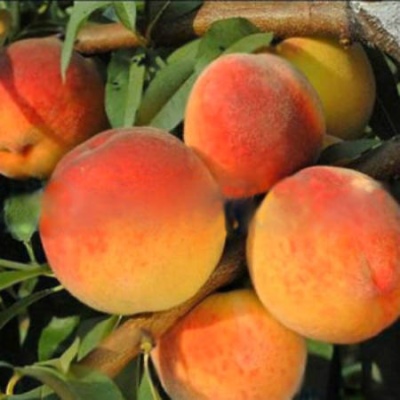
- Authors: Canada
- Growth type: vigorous
- Ripening period: late
- Appointment: for fresh consumption
- Yield: high
- Marketability: good
- Transportability: high
- Early maturity: in the 2nd year after planting
- Winter hardiness: high
- Disease and pest resistance: above the average
Royal Vee is one of the best peach varieties. Differs in a high degree of frost resistance, undemanding care and good yield. The fruits are consumed fresh. You can make liquor from the seeds.
Breeding history
The variety belongs to the Canadian selection, obtained by crossing the hybrid form 39058 (from Halehaven and Vedette) and the Veteran variety.
Description of the variety
The tree is compact, up to 1.5-1.9 m high, the crown is round and dense. Shoots are brown, strong, young - yellow-green. Leaves are oblong, elongated, pointed, curved, wrinkled, bright green. The flower is large, pink. Flowering begins in April.
Fruit characteristics
Peaches are medium in size, weighing up to 120-160 g, rounded, bright red, purple-red when fully ripe. The pulp is yellow, juicy, dense. The skin is thin, almost without pubescence. High transportability, peaches have an excellent presentation.
Taste qualities
Dessert taste, sweet and sour, with pineapple aroma. Tasting score - 4.7-4.8 points.
Ripening and fruiting
The tree begins to bear fruit in the 2nd year after planting, but it is recommended not to overload the plant with harvest until it gets stronger. Medium late ripening, the harvest ripens at the beginning of August, in very warm climates - at the end of July. In a state of technical ripeness, the fruits do not fall for more than 10 days.
Yield
Up to 45-50 kg are removed from one tree.
Growing regions
It is recommended to plant in central Russia and in more southern regions.
Self-fertility and the need for pollinators
Self-fertile variety does not require replanting additional pollinators.
Growing and care
Saplings are placed at a distance of 3-5 m from each other and from neighboring fruit crops. If the distance is less, then the plants will begin to shade their neighbors, this reduces the yield. The culture prefers sunny areas. Trees are watered as the soil dries up, young ones more often - 2 times a week, 1 bucket per tree. The soil should be wetted to a depth of 50 cm. In general, the agricultural technology of this species is quite simple and similar to other varieties of Canadian selection.
It is imperative to normalize the number of ovaries. Branches break off under the weight of the harvest. Fruit overload increases the ripening time, and the size of the peaches decreases. The crown needs regular thinning in the fall or spring.



Frost resistance and the need for shelter
The variety is characterized by high winter hardiness, the tree can withstand temperatures up to -32 degrees. In the middle lane, it is recommended to mulch the root area, insulate the trunk and crown with agromaterials.
Disease and pest resistance
Peach has above average immunity to major diseases. Very resistant to frizz. Weakly affected by the eastern moth.
He can get clotterosporium disease, for treatment it is treated several times: during the swelling of the kidneys with copper chloride or "Meteor", then before flowering with "Horus", "Topsin-M" means. All affected shoots are cut off, the cuts are treated with an 8% solution of lime with the addition of a 2% solution of copper sulfate, the cuts are covered with garden pitch.
To protect against powdery mildew, they are sprayed with Topaz, Skor, and Topsin-M preparations. From moniliosis, it is treated during the budding period with Topaz, and after flowering with Topsin, about 2 weeks after the first treatment. To prevent fungal diseases, all damaged branches are pruned in spring and autumn, fallen leaves are regularly removed and the earth is dug around the plant. Of the pests, aphids are the most dangerous, the affected areas are washed with soapy water with the addition of wood ash.

Requirements for soil and climatic conditions
Royal Vee ovaries are formed even under adverse weather conditions. Recommended for growing in mild southern climates and temperate zones. For planting, black soil or ordinary garden soil is suitable.

Review overview
In warm southern regions, the variety produces a huge harvest. In temperate climates, yields are good if you follow the main care recommendations. The fruits ripen tasty, but some do not like it because of the very dense pulp. Gardeners call Royal Vee trouble-free, since it practically does not get sick with anything, it winters and grows well.































































